“Small but mighty”. I think this is a quite fitting description of the island nation of Malta. We recently spent time here and highly recommend it especially for a winter getaway. Here are things to do in Malta and our five-day itinerary.
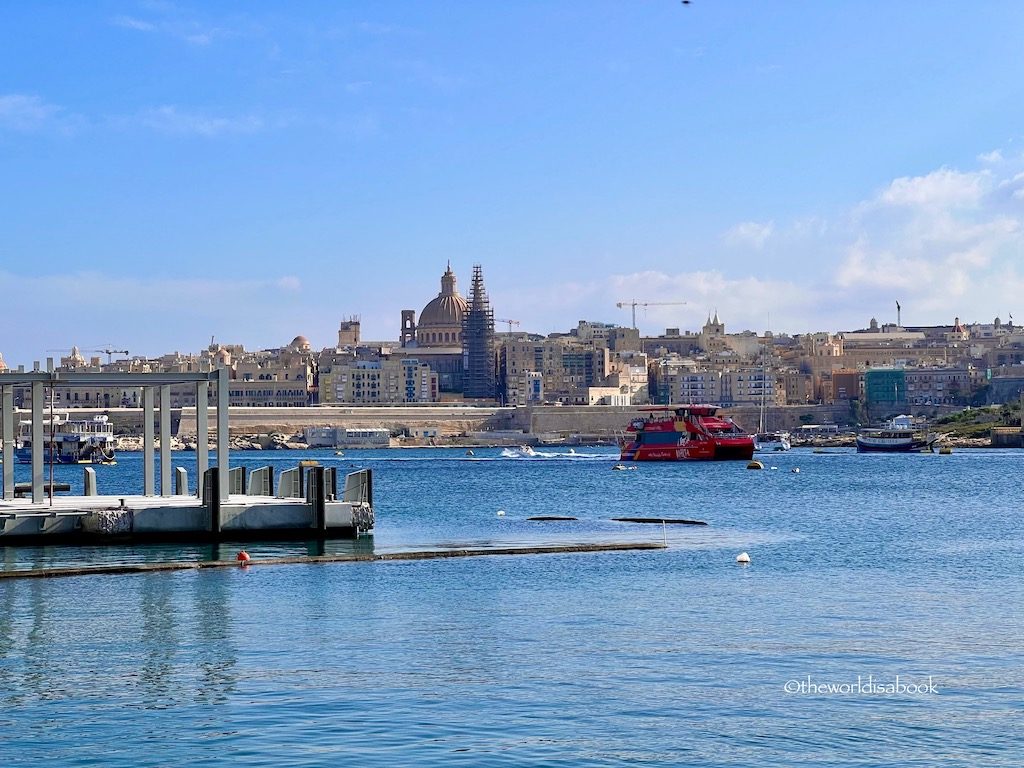
History
Situated in the Mediterranean and located 113 miles from Sicily’s coast, Malta may be small, but it holds so much interesting history, culture, and wonderful weather. Malta has one of the most interesting histories I’ve come across considering for its size.
If you mention famous conquerors, chances are they landed and left their mark in Malta during its early years, from the Phoenicians and Romans to the Arabs. One of its most famous residents was St. Paul the Apostle. In 60 AD, he experienced a shipwreck in Malta and introduced Christianity to its citizens.
More conquerers ruled Malta over the years from the Arabs, Aragonese to the French. The diverse rulers over the years have all left some interesting customs, traditions, food, architecture and ruins in the Maltese islands. It is such a wonderful blend and result from which makes Malta so unique.
One of the longest reigns were the British who ruled for over 160 years. Malta declared their independence in 1964 but still adopted many British systems.
English is one of their main languages. We saw plenty of the British red phone booths and they still drive on the left side. It is still part of the British commonwealth. It became part of the European Union in 2004.
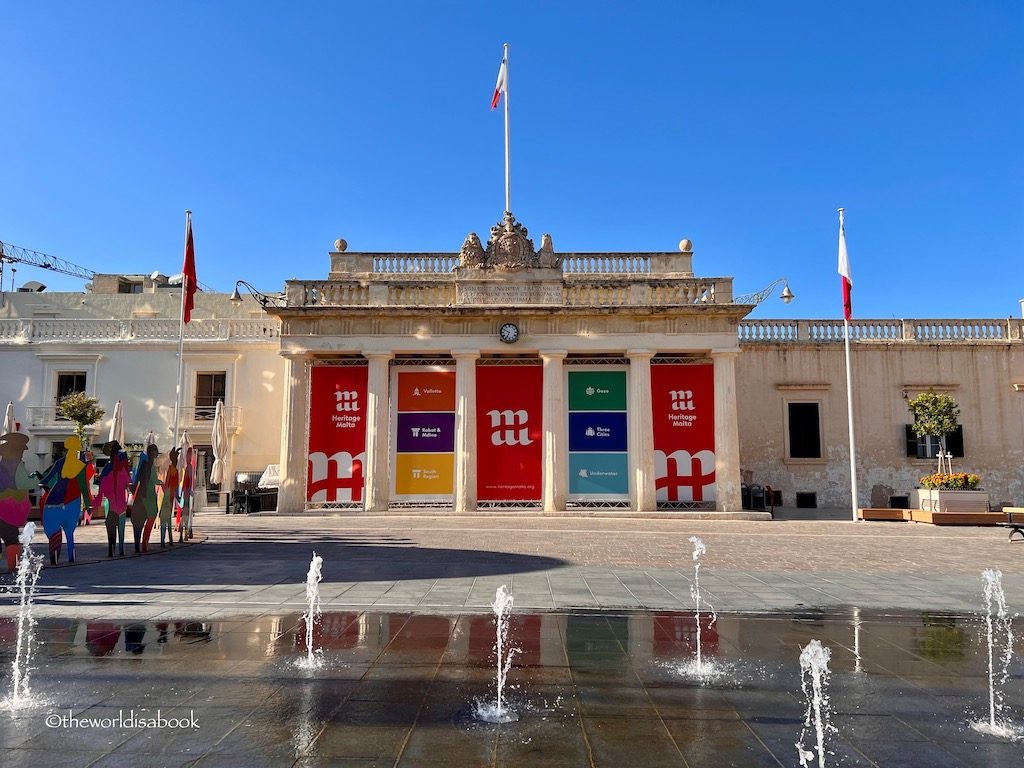
Malta Geography
Malta consists of six islands and islets in the Mediterranean. Its national name comes from the biggest of the islands at 96 square miles and 17 miles at its longest and nine miles at its widest. Gozo and Comino are the other inhabited islands.
5-Day Malta Itinerary
This was our five-night itinerary in Malta. It will give you a great orientation of the island. There were many other things we didn’t cover but these were our highlights and recommendations. For once, it was actually a mix of some relaxation and sightseeing compared to our other European itineraries.
DAY 1 – Flight Arrival and Tour of Valletta
Our flight arrived in Malta before 10 AM. The airport lands in a small airport. There are several options to get to the tourist areas: bus, taxi, uber/bolt. We used Bolt which is a ride share company similar to Uber and got to the xx area in 20 min for about 30 euros.
We spent the rest of the afternoon walking around Valletta, the capital of Malta. Depending on where you’re staying, Valetta is centrally located and easily accessible by buses, taxis and share rides.
We used the bus to get around Malta. Bus fares were around 2 euros. Buses drop off passengers in front of the Triton fountain. This leads to the gate entrance to the once fortified city of Valletta.
Touring Valletta
One of the things we loved about walking around Valletta is looking up and seeing all the colorful bay windows or balconies. These colorful, wooden and enclosed balconies were unique and add so much character to the buildings.
There are conflicting origin stories of why there are so many bay windows around Malta. The bay windows also usually matched the colorful doors and unique door knockers of the buildings.
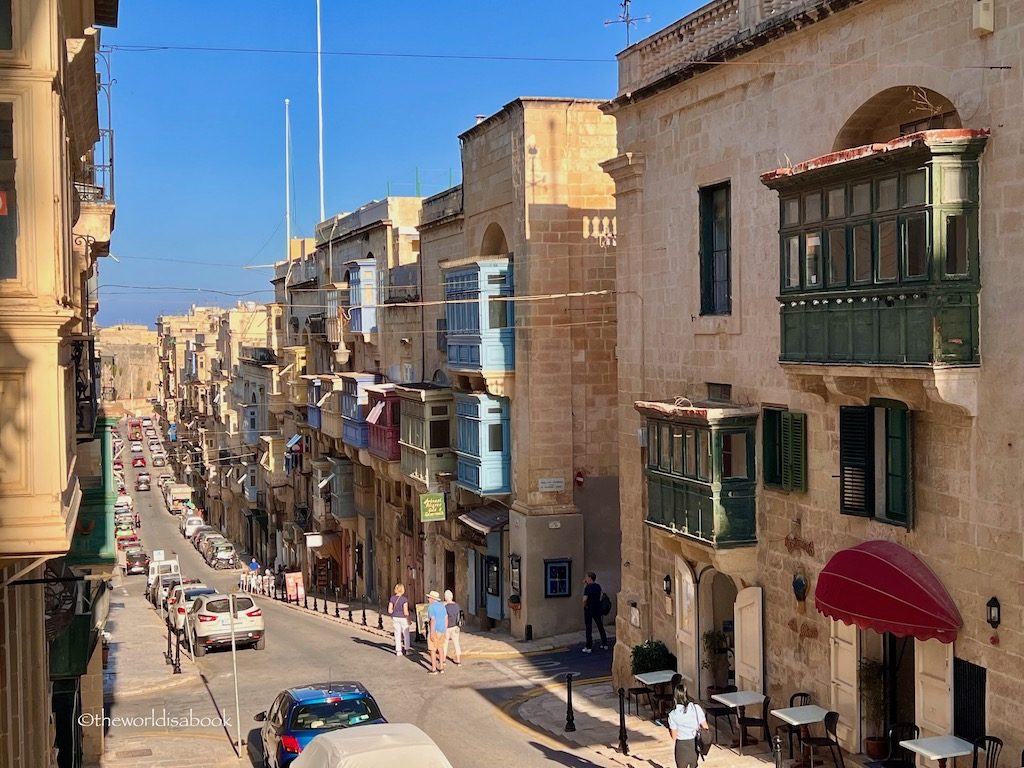
A consensus seems to be that these balconies/bay windows are of Arabic origin and became popular in the late 17th century. It was built on the idea that the women (who were typically housewives) watched the world go by below their balconies without being seen. In Maltese, they are called “gallarija” which translates as gallery.
We really enjoyed exploring the many corners and side streets of Valetta. Most of the buildings were constructed using soft limestone, which is also the primary material forming the islands.
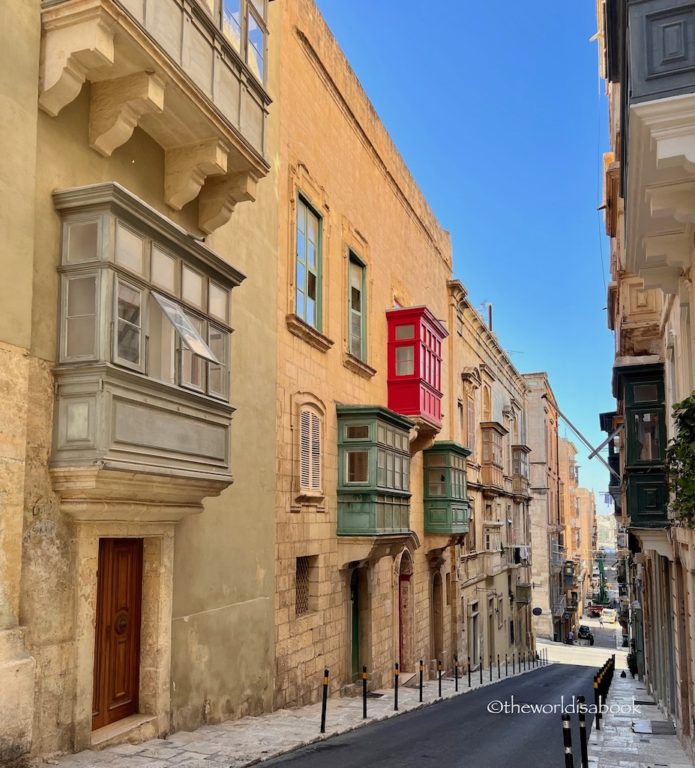
Visit Churches and Museums
There are several churches and museums worth exploring around Valetta depending on your interests and time.
National Museum of Archaeology – This museum houses many artifacts spanning the Neolithic to the Phoenician period that spans 7,000 years of history. It gives an “insight” into the various civilizations that have lived in or occupied Malta. A museum highlight is the 5,000 year old statue of the “Sleeping Lady”.
Grandmaster’s Palace or The Palace – This was originally the Grand Master of St. John’s 16th century palace. It is currently the Office of the President of Malta’s resident. Heritage Malta runs the Palace State Rooms and the Palace Armoury as a museum and is open to the public.
Fort St. Elmo – National War Museum – They strategically built this star-shaped fort in 1552 to fight off the Ottoman armada’s invasion.Its prominent position had panoramic views of the neighboring harbors and towns. Over the years, they made additions to the fort, including bastions, barracks, and even a lighthouse.
Its role in some sieges and wars made it the perfect spot for the National War Museum. The museum has six sections that houses many exhibits from the Bronze Age to 2004 when it joined the European Union. That’s 7,000 years of Malta’s military history collection!
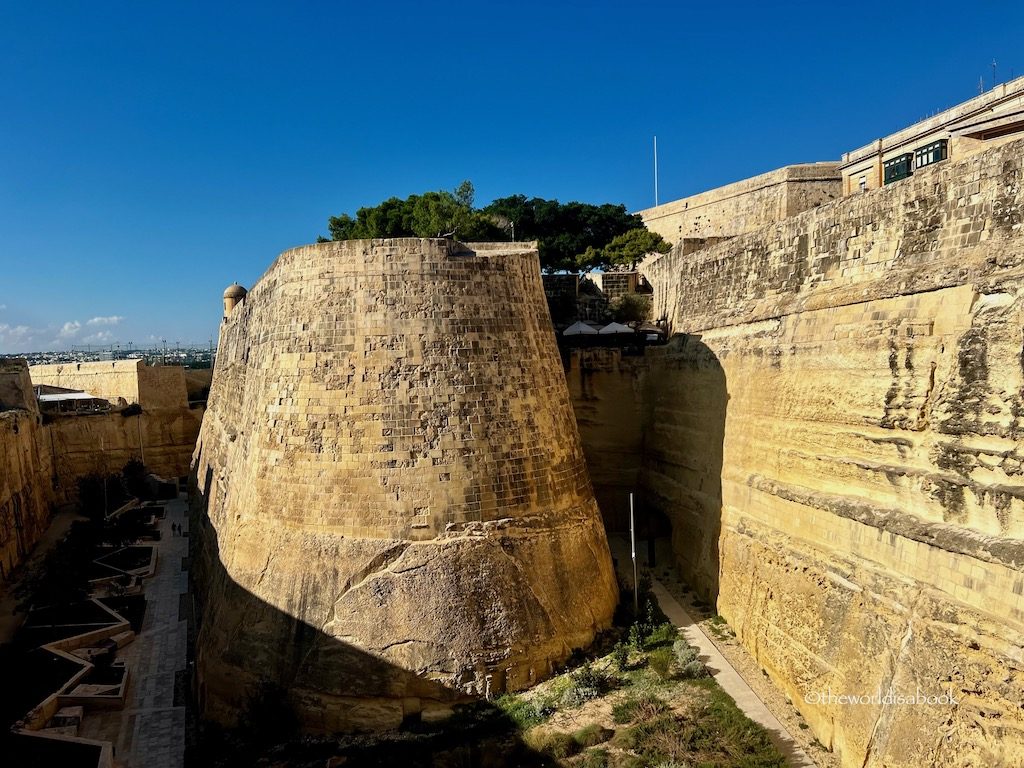
A Very Unique Church
St. John’s Co-Cathedral – It’s hard to miss this large dome that dominates Valletta’s skyline. The magnificent Roman Catholic cathedral is a dedication to St. John the Baptist.
The Knights of Malta built this church in the 1570s. I’ve never heard of other churches being called a co-cathedral, but they named this one this way since it shares Malta’s Roman Catholic Archdiocese seat with the St. Paul Cathedral in Mdina.
The Baroque cathedral houses several Caravaggio paintings and a collection of donated artworks and relics from the knights and Grand Masters. Caravaggio’s largest work of art which is the 17th century “The Beheading of St. John the Baptist”.
The cathedral’s interior is amazing and worth a visit if you have some time. It is one of the most popular attractions in Malta.
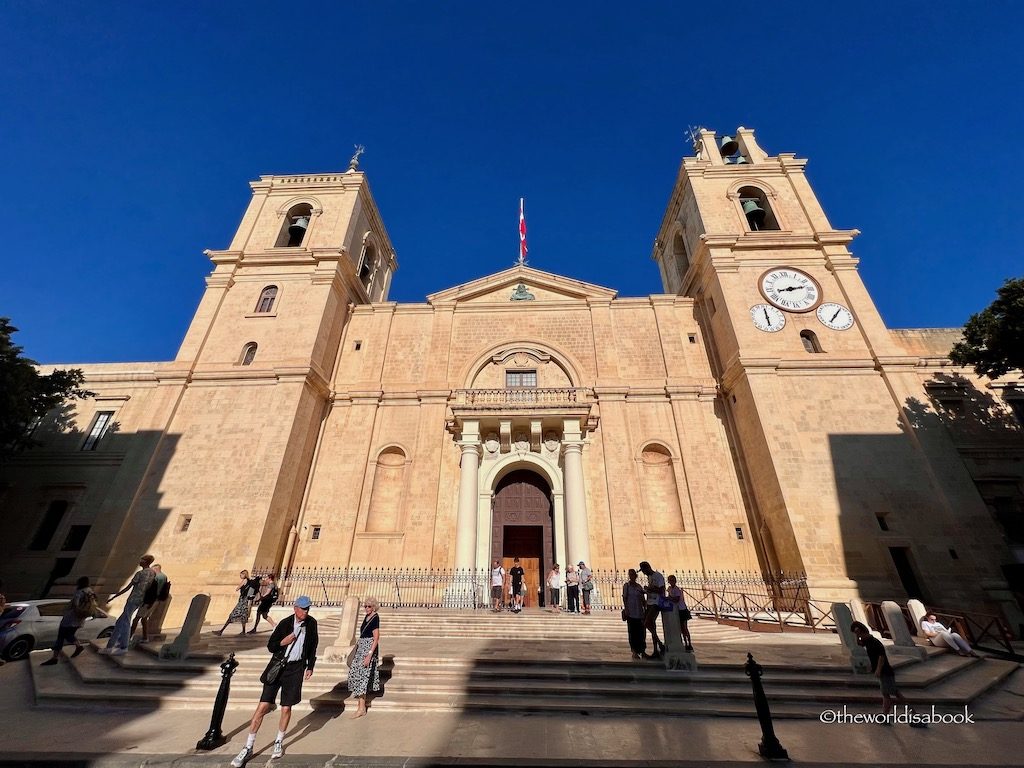
Check out Is-Suq tal-Belt Food Market
One of the best places to check out and grab a bite to eat in Valletta is the Is-Suq tal-Belt Food Market. Located in a 200 year old historic building, It has four floors consisting of a market, restaurants and plenty of seating. We enjoyed the variety of food selections that we actually ate here twice.
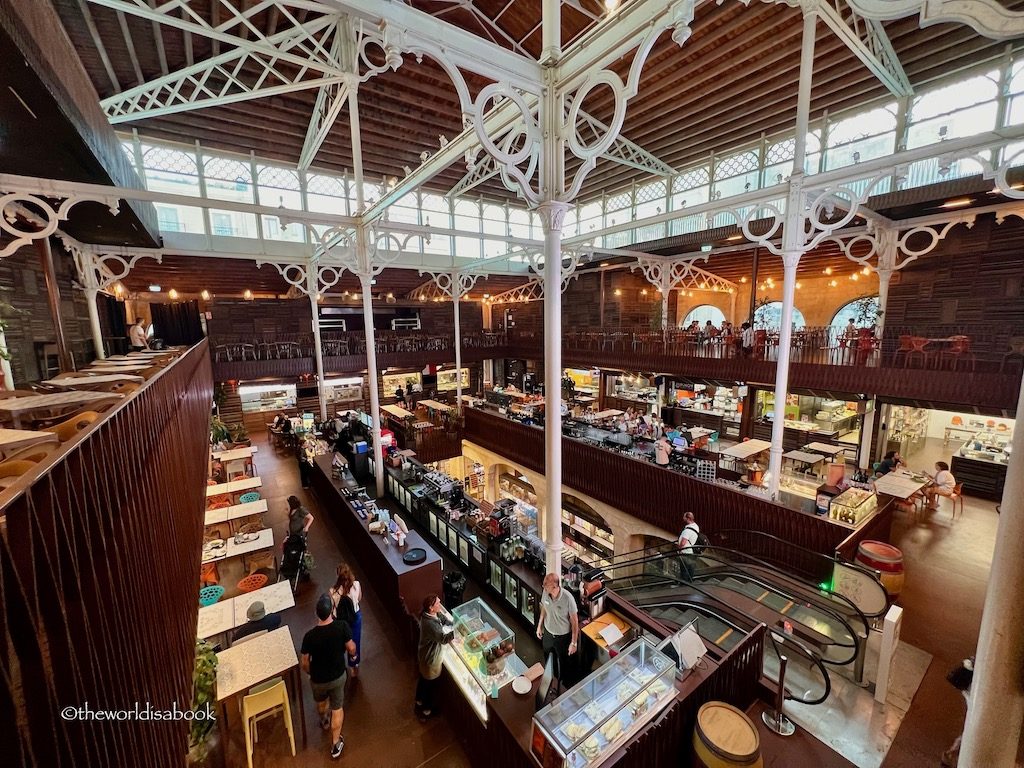
It doesn’t just cater to tourists but also locals. Visiting this food hall was like sampling dishes from around the world. There was Japanese, Italian, Chinese, Indian, Maltese and even Filipino cuisine.
As Filipinos, this was a welcome sight. The bottom area is a food market and bakery. It was a great way to explore and see local grocery items.
We highly recommend going to either the Upper Barraka Gardens or along the city walls near the Dom Mintoff Monument for panoramic views and some wonderful sunsets.
Valletta is also a wonderful place to explore at night. The streets were quieter after day trippers and cruise ship crowds have gone. But, there was still a lot of activity with all the restaurants and bars coming alive. The Triton Fountain is also lit up beautifully. There are also sunset and night cruises around the Grand Harbour available.
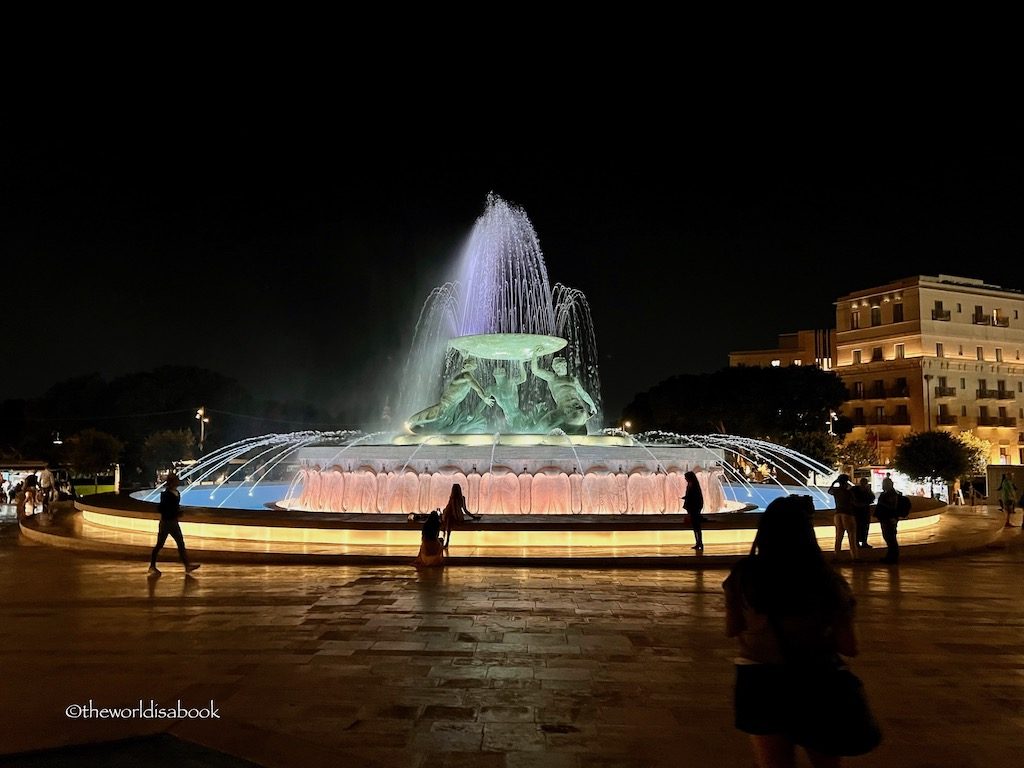
DAY 2 – Valletta /Mdina
One of Malta’s top attractions is watching the daily cannon firing at noon and four PM at the Saluting Battery in the Upper Barraka Gardens. The cannons are located on the garden’s ramparts with amazing panoramic views of the Grand Harbour and Three Cities.
It’s a wonderful homage to Malta’s history. These cannons have protected Malta’s harbor for almost 500 years.Eventually, this area also became the nation’s main place for gun salutes to commemorate anniversaries, feasts and welcome important ships/boats into the harbor.
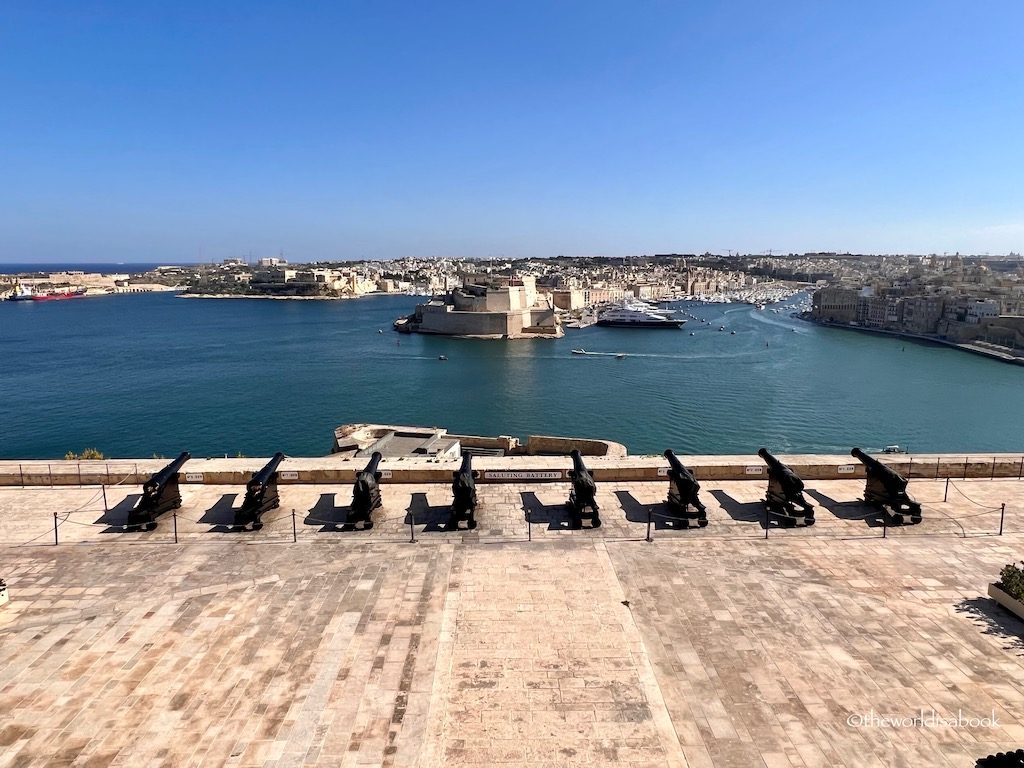
While it is free to watch the firing of the cannons from the terrace of the gardens, we highly recommend paying the three euros to go down and be close to the action. Even at 11:30 AM in early November, the free viewing platform was quite crowded. So, imagine how crowded it would be during the summer.
The guards provided a wonderful explanation of the cannons’ history, how they worked, how they were loaded, and how they were fired. We enjoyed the experience of being so close to the cannon being fired, and it was loud.
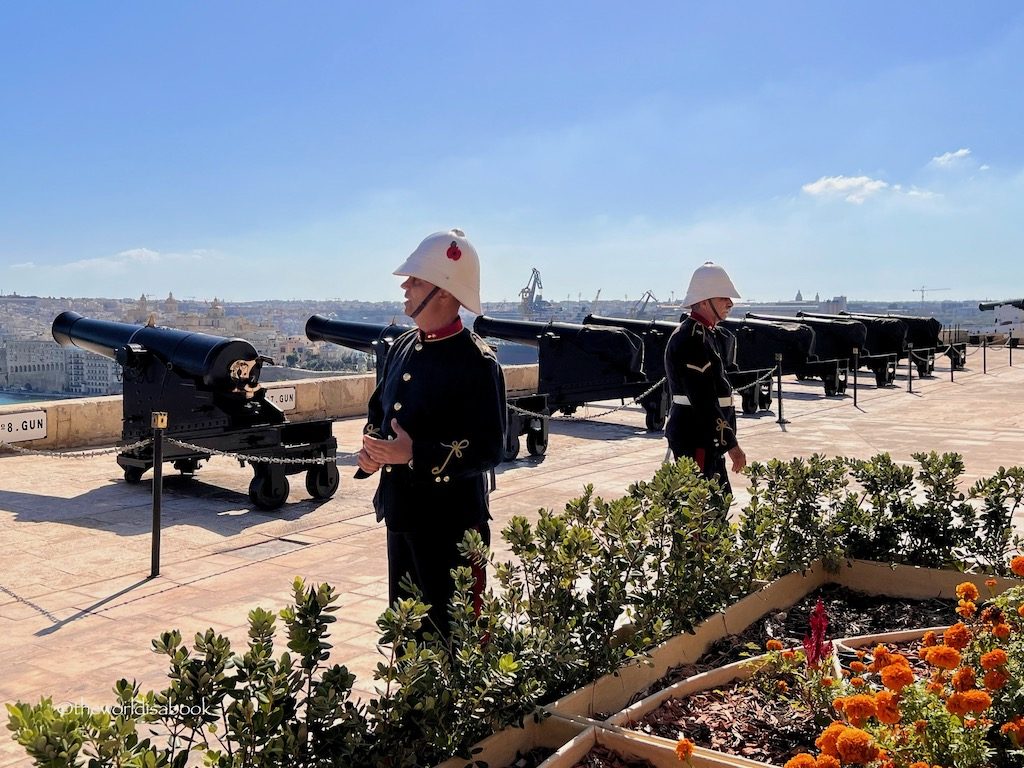
Afterwards, we joined an English guided tour of the history of the cannons and some information on the exhibits around the complex. Visitors could also visit some rooms with artillery and equipment and get closer looks at the various cannons.
Explore Mdina
We highly recommend taking the bus and spending the afternoon in Mdina. If you can, allocate some time here and the neighboring town of Rabat. Located in the center of Malta on a hill, it almost looked like those fairytale towns. They built it as a fortified medieval town “enclosed in bastions.”
Mdina (pronounced muh·dee·nuh) was once the capital of Malta. However, after they moved the capital city to Valletta, many people also relocated. Mdina became eerily quiet with hardly any residents and almost became like a ghost town. Thus, the nickname of the “silent city” was born.
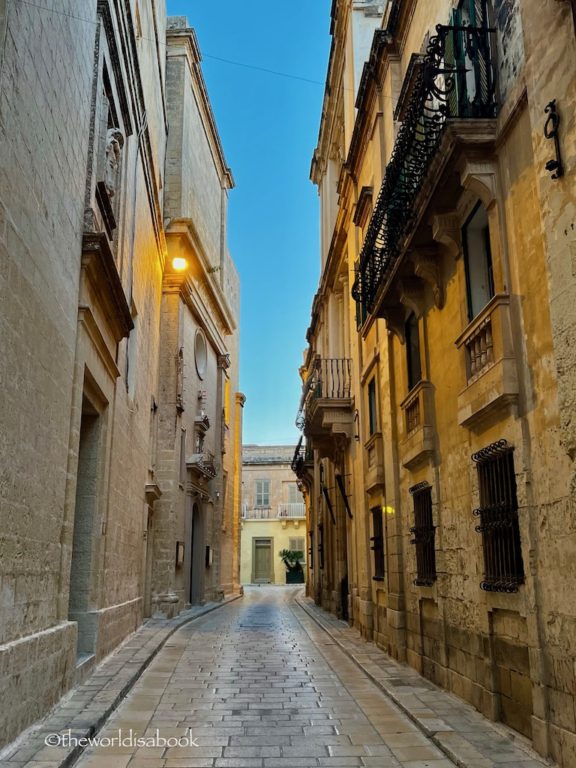
Mdina History
Its history goes back over 4,000 years. In 60 AD, St. Paul (the Apostle) lived here after experiencing a shipwreck. The Arabs ruled the island around 870 AD and changed the city’s name to Mdina which meant “town surrounded by a wall”.
Mdina was such a charming and beautiful city. If you’re a fan of the popular Game of Thrones series, the filmmakers used several scenes around Mdina, starting with the bridge and entrance gates into the city.
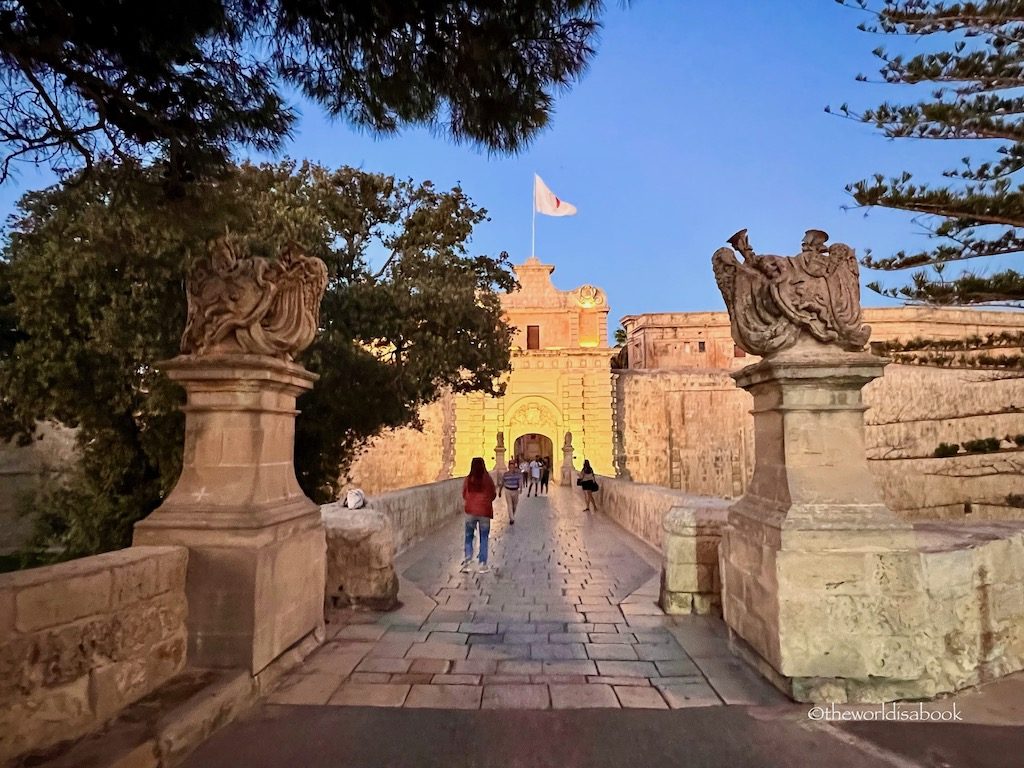
Exploring Mdina
We loved walking around and getting lost around Mdina. It almost felt like we stepped back in time. The narrow streets and alleyways were so quaint and beautiful. There were also many colorful bay windows much like Valetta. They do not allow cars (except for some residents), so they largely pedestrianized it.
One of the best ways to explore the town is to take a carriage ride through Mdina’s narrow streets. There was something quite romantic about seeing Mdina this way especially during dusk. I now regret not doing this tour.
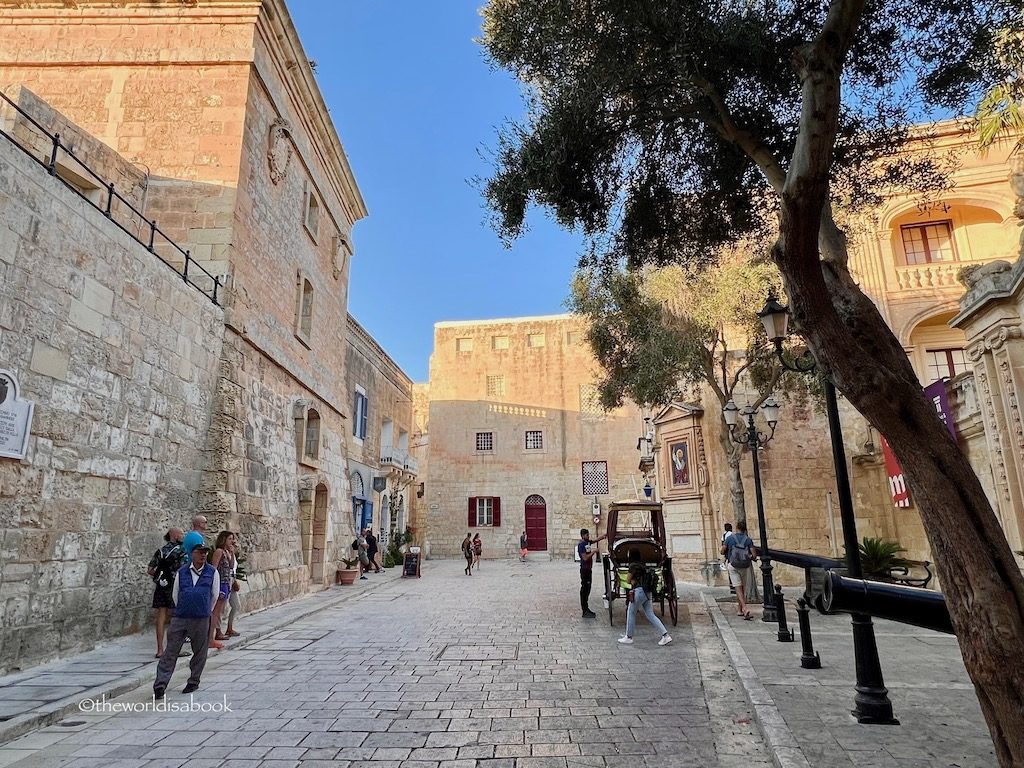
Most of the Baroque structures here were once palaces but are now private homes. We were here right before sunset and it almost looked like the buildings glowed. The medieval town had several religious and cultural buildings to visit like the Cathedral Museum, Dungeons Museum, National Museum of Natural History (by the entrance) and Church of the Annunciation of Our Lady.
Keep walking towards Bastion Square and the Fontanella Tea Garden restaurant. This restaurant had amazing views, by the way. There was a lookout wall here that showcased views of the countryside and nearby villages.
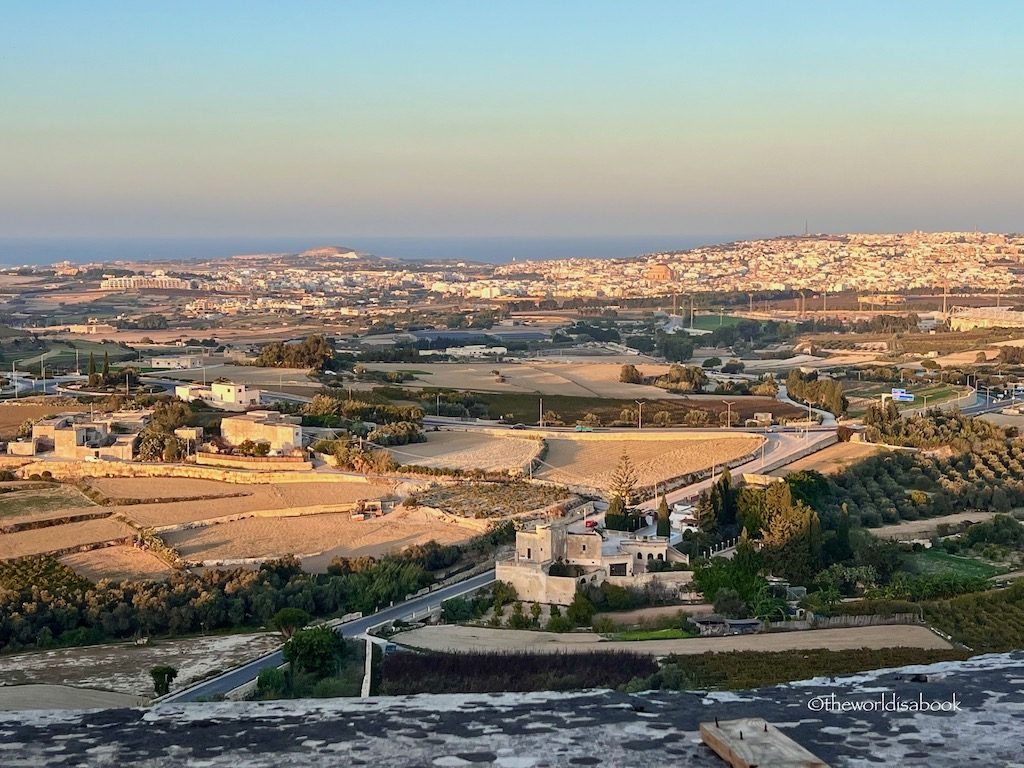
The Main Square
The main square of Mdina was anchored by the 17th century Cathedral of the Conversion of St. Paul. It’s hard to miss the large dome. Coming here around sunset changed the church’s exterior color and it was gleaming in the sun’s rays. The church was free to enter so don’t miss going inside.
This majestic church was believed to have been built over Publius’ house (the Roman Governor). He welcomed St.Paul to the island and this was also where St. Paul converted Publius into Christianity.
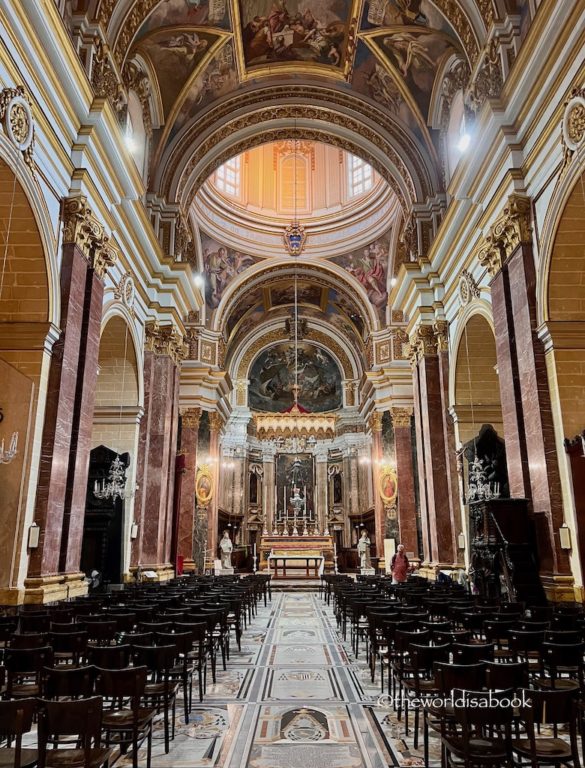
It was also a great town to shop for some unique souvenirs. Mdina is known for handmade glass items. The store by the gate entrance was filled with some wonderful glass products and it’s almost a guarantee you won’t walk away empty handed.
DAY 3 – Sliema/Three Cities/St. Julian
This was a hotel switch day and we didn’t get to do as much as we wanted. We spent the morning in the Sliema area. Located centrally in Malta, Sliema has some wonderful shopping areas and many restaurants and bars (some overlooking the ocean).
We got off the bus at the Ghadir stop and walked the rest of the way to Sliema’s central area. There were some nice beach areas here and some nice spots to watch the ocean or sunbathe. Though, these beaches were unlike ours in San Diego with no sand. But, it had some very interesting interesting rock and hardened sand formations along with tide pools. It was a beautiful area to relax.
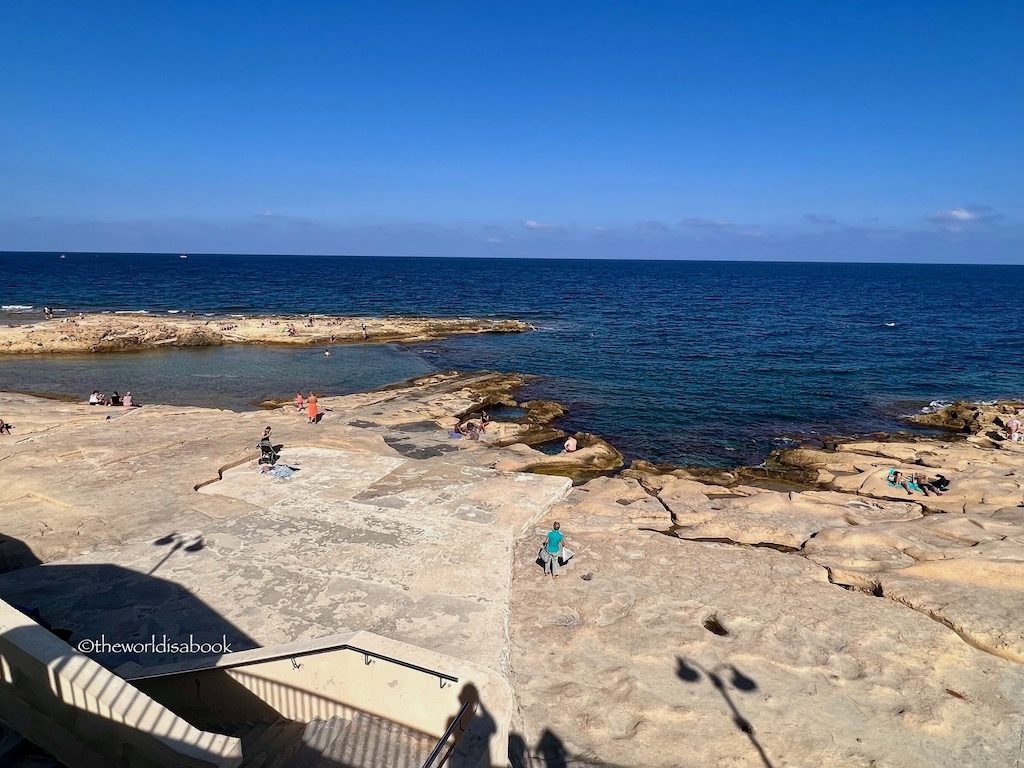
Sliema also has a seaside promenade that stretches for about 3.1 mile (5 km). This area was a bit more modern but walk a few streets inland and the historic Maltese buildings with the traditional bay windows are still around.
We enjoyed walking around this busy area and shopping at the many mainstream stores. This was one of the best places to find favorite European stores. The Point Shopping Center is the island’s largest shopping mall.
Three Cities Tour
If we had the rest of the afternoon off, I would recommend doing the Three Cities tour. Sliema is the ideal place to catch several cruise tours that include. Three Cities is the unified name of the fortified towns of Cospicua (Bormla), Senglea (Isla) and Vittoriosa (Birgu) in Malta’s historic center across from the Grand Harbour.
This area is one of the best places to see and learn more about Maltese history and culture. The Three Cities is like a living history of Malta and open- air museum. The Knights of St. John made their first home here in the 16th century leaving palaces, churches, forts and bastions that visitors can still explore today.
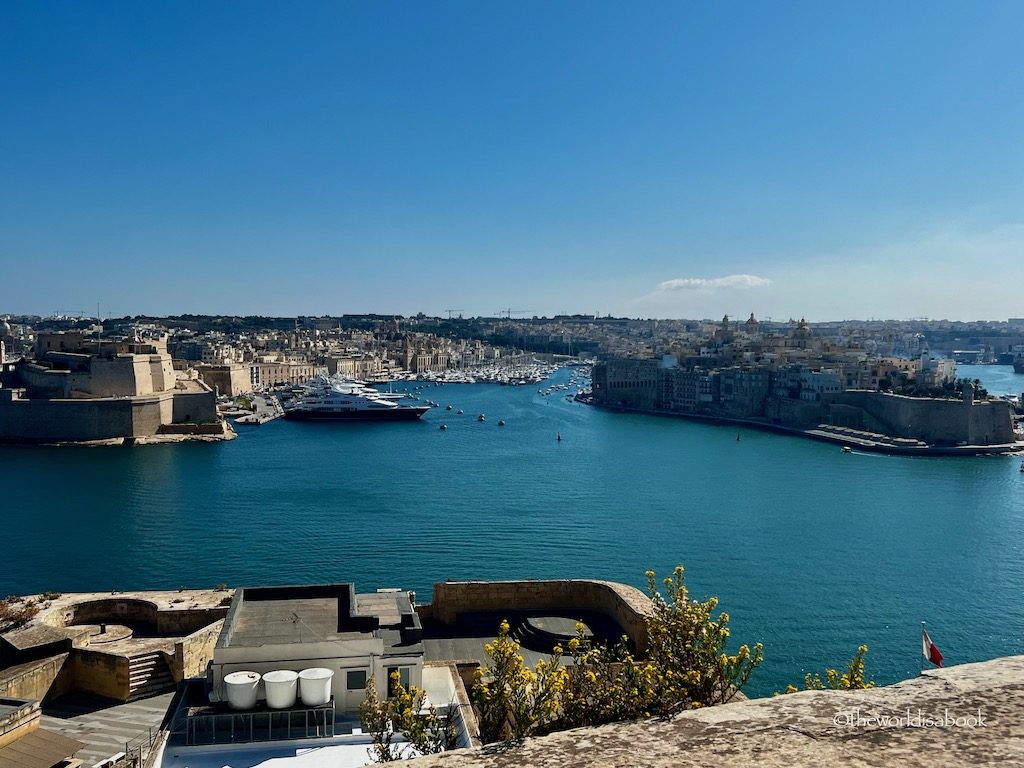
There is a combined ticket to some of the Three Cities most popular attractions which include the Malta Maritime Museum, Inquisitor Museum and Fort St. Angelo. A yacht marina and many restaurants, cafes and bars have revilatilzed the area in recent years.
Some Three Cities tour you can take from Sliema include:
- Guided Three Cities tour with boat tour
- Three Cities Tour and Wine Tasting
- Valletta and the Three Cities Scenic Cruise
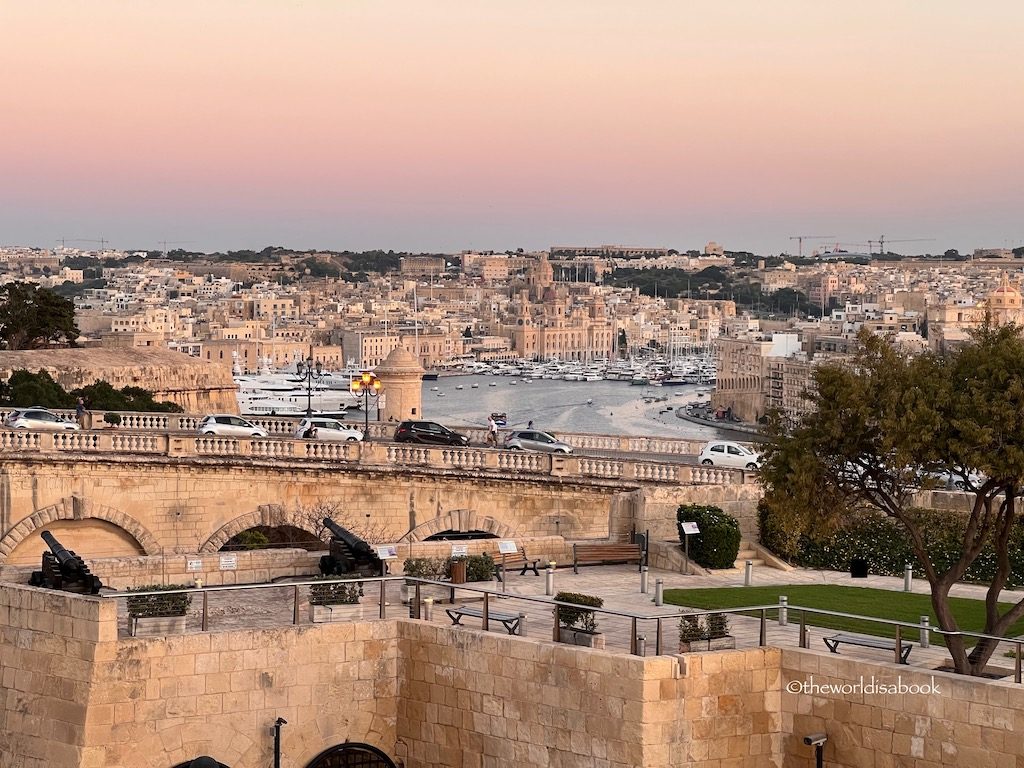
St. Julian
We moved to a hotel in the St. Julian (San Giljan) area and explored the area at night. St. Julian is located on Malta’s northern coast and considered more modern and urban catering to tourists with some high rise buildings and many hotels.
St. Julian and especially Paceville is the nightlife hotspot of Malta with many nightclubs and bars. We also found a large movie complex, a bowling arena, casinos and a shopping mall.
While in the St. Julian’s area, we enjoyed walking part of the 4.3 miles (7 km) promenade and also spent another night walking around Spinola Bay. Don’t miss the LOVE sign.
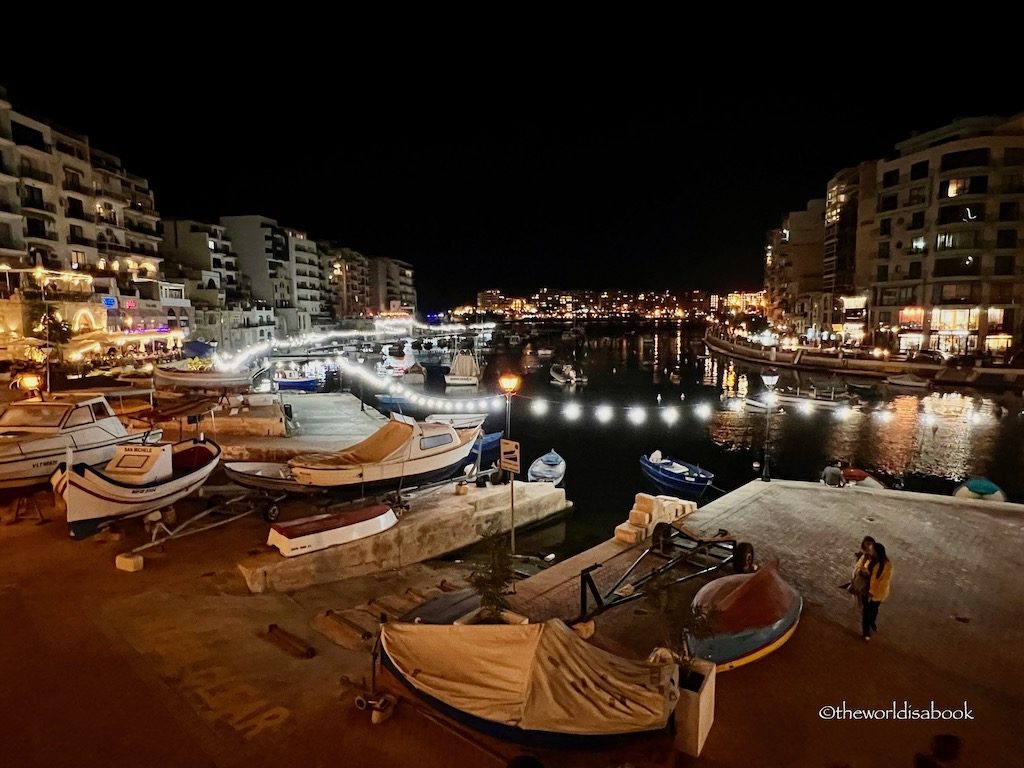
DAY 4 – Valletta/Marsaxlokk
One of Malta’s draw for my husband was the chance to relax by the water in a place with milder weather in early November. It was a bonus to have found two great hotels including a five-star seaside resort. So, we spent the morning enjoying the resort. If it were up to me, we would have been exploring more of Valetta and visiting some museums and churches.
Exploring Marsaxlokk
One of our favorite areas in Malta is Marsaxlokk pronounced marsa-schlock. Its name means southeastern port due to its location on the island. It is about a 45-minute bus ride (lines 81 or 85) from Valletta but quite different and where we spent the afternoon. Since we were in Valletta to catch the bus, we also ended up exploring the city again at night.
Marsaxlokk is Malta’s largest fishing village and supplies most of the fish sold on the island. Their harbor is quite big and is filled with traditional and colorful fishing boats called luzzus.
This was quite possibly the most colorful and one of the most photogenic harbors we’ve visited. This natural harbor has been as a landing spot used for many centuries from the Phoenicians, Romans to the Arabs.
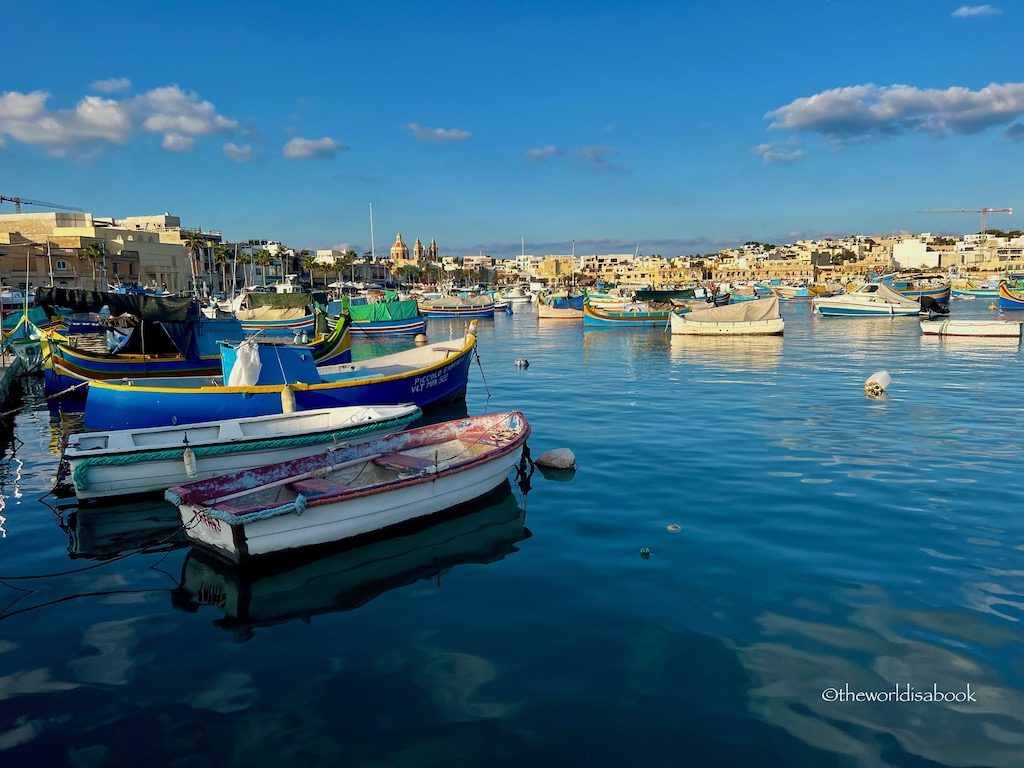
The Luzzus
I loved that the front of most of the luzzus had painted or engraved eyes. They called these eyes Eye or Crisis or Eye of Horus, who was the God of Protection from evil in Phoenician tales. Fishermen believed these eyes protected them from evil and harm while out at sea.
Families have passed down the luzzus from generation to generation, from fathers to sons. They generally keep the colors of the luzzus the same after inheriting them due to superstitions.
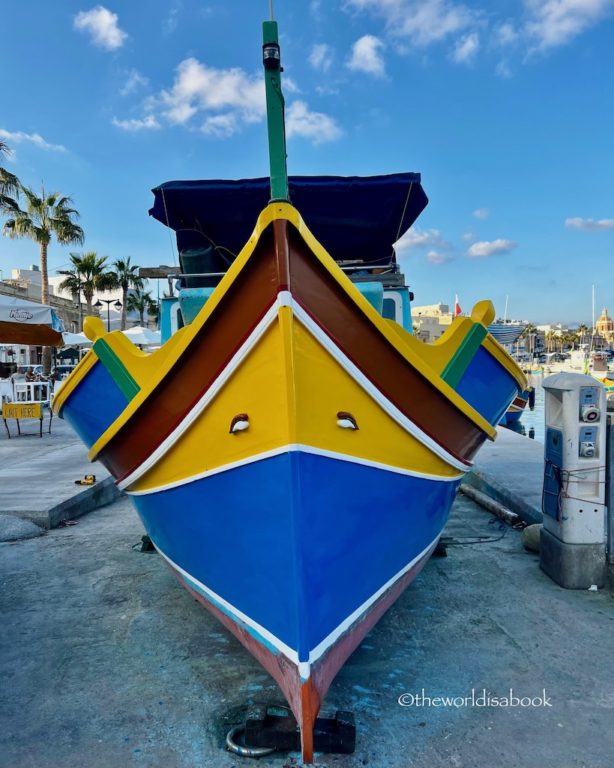
Exploring the Promenade
If you are a seafood lover, this is the place to go to sample some of the best restaurants on Malta. This harbor walk area abounds with restaurants and bars. We had one of our best lunches on this trip here. It was wonderful to sit by the water while eating and watching all the activities.
We enjoyed walking the promenade and watching all the activities of the fisherman. They were very interesting to watch. The most prominent building here is the beautiful church dedicated to the Madonna of Pompeii. Don’t miss going inside the beautiful church.
A popular excursion from Marsaxlokk is St. Peter’s Pool which is a popular swimming area nearby. There were several vendors selling some boat tours along the promenade.
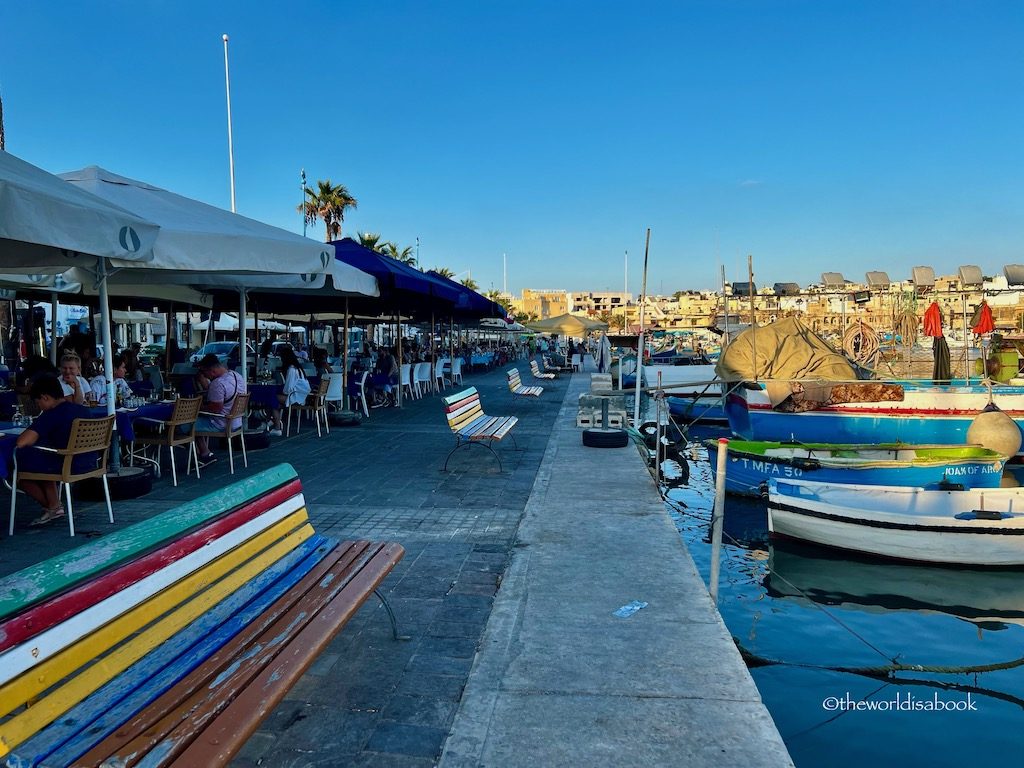
There was an open-air market here everyday selling souvenirs, local food items, clothes, etc. Though, the best time to go to Marsaxlokk is on Sunday when the market is bigger. The locals come to shop at the fish market for the freshest seafood straight from the fishermen’s boats. Though, keep in mind that Sundays get very crowded.
Many buses serve Marsaxlokk from various tourist areas around Malta. Though, most stop in Valletta to transfer buses. There is also a Hop-On/Hop-Off bus tour (the southern route) which includes a stop here.
DAY 5 – Gozo Island
if you can only do one day trip from Malta, make sure it is to visit its sister island of Gozo. It was a quick 25-minute ferry ride from either Valetta or Ċirkewwa on the northernmost part of Malta.
We found Gozo to be more laidback, less crowded and more rural than the Malta main island. Despite its small size, it also offers a wealth of history, culture and some interesting attractions. Gozo’s main attraction is the citadel that looms over the island.
It’s hard to miss this structure and has served many purpose over the years from a sanctuary for its citizens from many invasions to a fort and museum. The island is also known for its many salt beds along the coast.
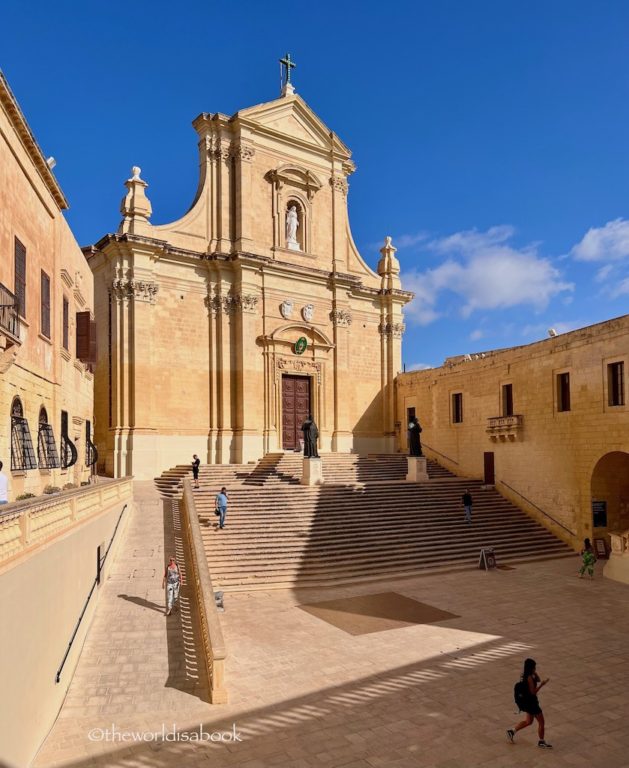
My favorite natural attraction was the Senap CLiffs. These white limestone cliffs along the coast were beautiful. The whole area offered amazing panoramic views. It’s also one of the best places to watch the sunset.
Read more about how we spent our day in Gozo Island including all the tips to getting there and the attractions we saw on our tuk tuk tour.
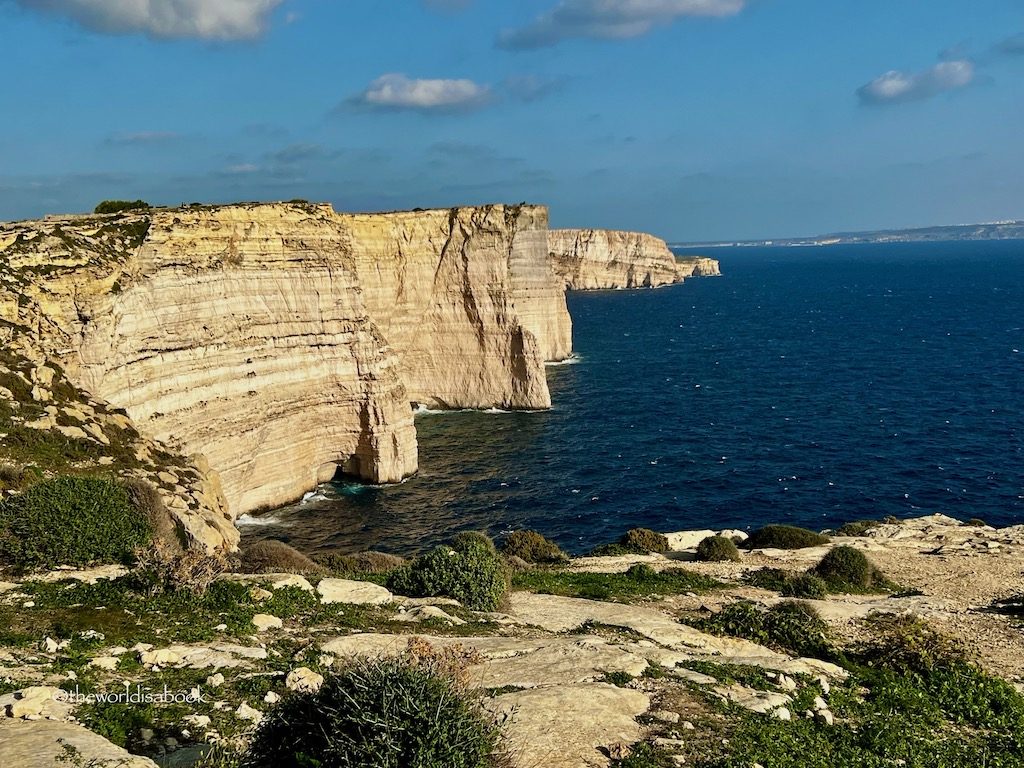
Our brief stay in Malta gave us a glimpse of the main attractions and the beauty of its islands. We can’t wait to return and bring our kids with us next time. We highly recommend visiting this underrated country. There was so much culture, history and unique attractions.
Tips for Visiting Malta
*Travel in the off season if you can. Malta is a wonderful destination year round. Several locals have told us that the summer season gets very hot and quite busy. We were here in late October/Early November and it was such pleasant weather, barely any crowds and cheaper accommodations.
*Stay Central. If you’re looking for a more central location, try staying in the Valetta or the Sliema area. We chose these two properties since my husband has status at Marriott hotels. Their location wasn’t that much of an issue since there were bus stops.
*Take the Bus. There is no subway system but a vast network of bus system and a lot of ride shares like Uber and Bolt and plenty of taxis. We mostly rode the bus to get around the island. Determine how many times you may need to ride the bus and how much you’ll spend. Fares are 2 euros during the day and 3 euros at night.
Based on our itinerary and where we were staying, we figured we needed to get the 7-day “Explore Card” even though we were only here for six days. This allowed us to hop on or hop off anytime during our stay.
We learned fast that we needed to flag the buses down or some will not stop. Buy the card at the bus station complex at the ticket kiosk.
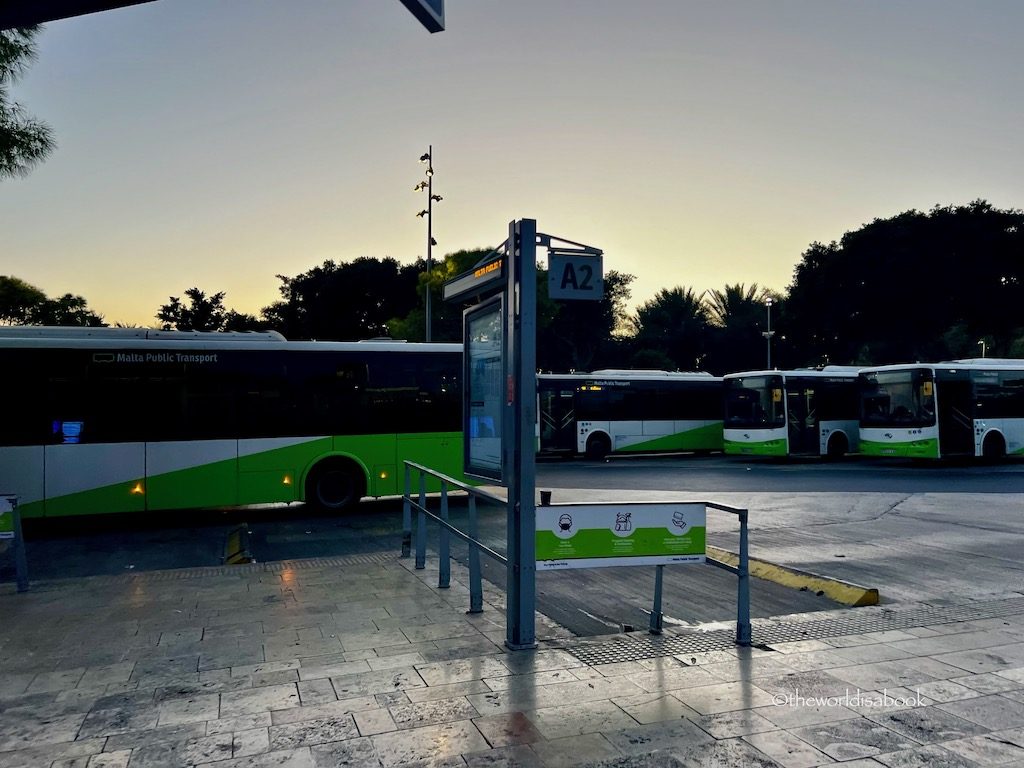
What/Where to Eat in Malta
Eddie’s Cafe Regina – This was our first lunch in Malta. It was right in the middle of Republic Street in front of the National Library in Valetta. They do get quite busy but if you come around 2 PM, the crowds thin out. Being close to Sicily, pasta is very popular in Malta. The pasta dishes here were tasty and most dishes were affordable. It was also a great place to people watch.
Aaron’s Kitchen – My husband found this highly rated restaurant in Valletta and it also happened to be a Michelin star restaurant. They described themselves as a “A Truly Maltese Family Hospitality Experience” and we really enjoyed our lunch here.
My husband decided to try the rabbit patties appetizer here. Rabbit, prepared in several ways, is one of Malta’s specialty dishes. We also had the seafood platter which was delicious. Prices were great for the amount of food and quality.
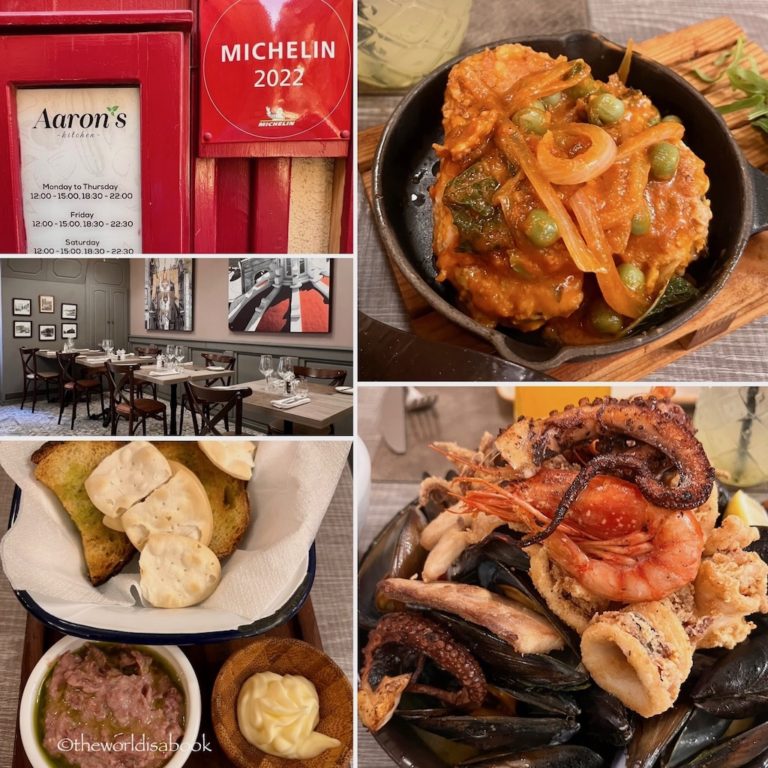
Pisces Restaurant – We really enjoyed the ambience at this seaside restaurant in Marsaxlokk. Food was fresh, delicious and they had reasonable prices. There were several restaurants all lined up along the promenade so you really can’t go wrong with any of them.
Opa! Mediterranean Fusion – The Sliema area is full of wonderful restaurants and cafes. If you’re craving for some Mediterranean food since you’re in the region, this offers a good variety of dishes. We enjoyed our kebab dishes and portions were great for the price.
Is-Suq tal-Belt Food Market – This is one of best places to eat in Valetta for convenience and variety. We ate here twice while walking around Valetta and highly recommend it for the variety of international food options. There are some local Maltese food stalls. Plenty of seating options.
What to eat/drink in Malta
Pastizzis are Malta’s most popular street food. These pastries are sold in many cafes and restaurants and in specific shops around Malta. We found a few pastizzi shops by the bus station area near the Triton fountain in Valetta.
These crispy pastries are made of flaky phyllo dough and have various fillings. Some of the most common fillings are peas, ricotta cheese, spinach, anchovies or chicken. I wasn’t a fan of the peas but the cheese and chicken were good. They’re easy to eat and cheap at usually less than a euro or a few cents.
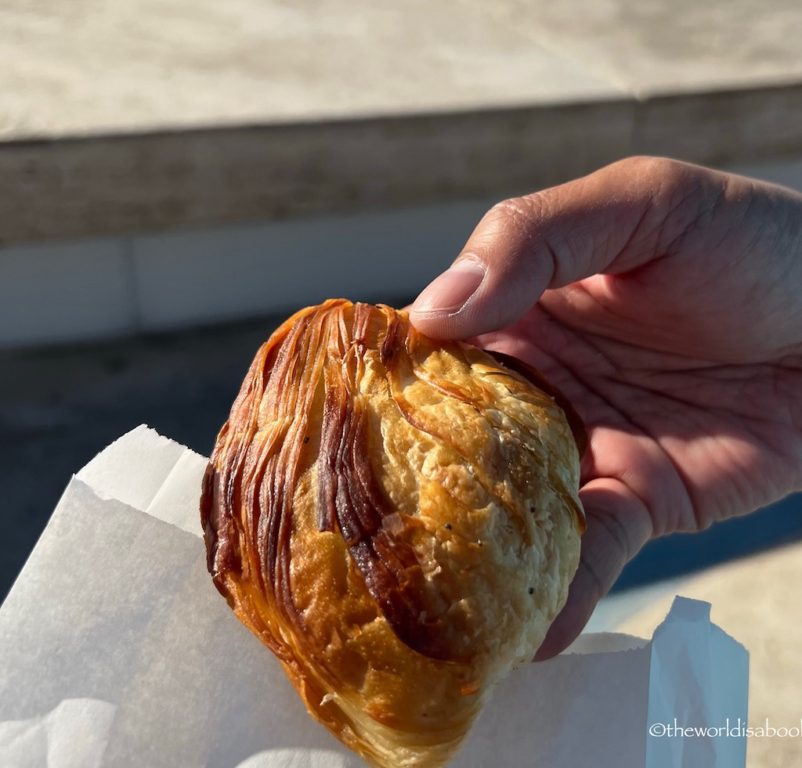
Rabbit dishes was a staple in many Maltese restaurants and prepared in various ways. The national dish is called ‘Stuffat tal-Fenek’ which was traditional Maltese rabbit stew. There are also braised and fried rabbit versions. We tried the rabbit patties and they yes, it tasted like chicken.
Kinnie – We found this Maltese soda everywhere and knew had to try it. This drink is made from bitter oranges and wormwood extracts along with other flavors. This tasted better cold but still an acquired taste and I wasn’t particularly fond of it.
Ċisk (pronounced Chisk) is Malta’s most popular beer. My husband likes to try beer when in a new country. He actually liked this golden lager for its lightness. They also had a low carb version (Cisk Excel) and fruit versions too if you want a bit more flavor.
Bisuttini tar-Rahal – Known as Village Biscuits or cookies, the treats found around the island. Our hotel had this and they were delicious and addicting..
Ottini – These are spiced shortbread biscuits traditionally eaten during tea time. Our hotel had this too and we enjoyed eating them during our snack time.
Where to stay in Malta
We stayed at two Marriott properties in Malta. We highly recommend these two hotels for their location, amenities and service. For everything it offered, both hotels were such great rates since we were traveling during the low season. The upgrades helped a lot too since my husband has a high status in their Marriott Bonvoy loyalty club.
Malta Marriott Hotel & Spa – Located across the street from Balutta Bay Beach, this 5-star hotel was in a more busy area. They had a wonderful Marriott Club Lounge and beautiful views from it with plenty of options for dinner/happy hour. Breakfast was a buffet option at their restaurant and had many wonderful varieties.
Westin Dragonara Resort Malta – This was one of the best hotels we’ve stayed at. This family-friendly, five star resort was beach side with a great pool. It was within walking distance to entertainment complex, shopping mall, bars.n nightclubs and the Malta Casino ext door. The lounge offered wonderful options for breakfast and happy hour/dinner.
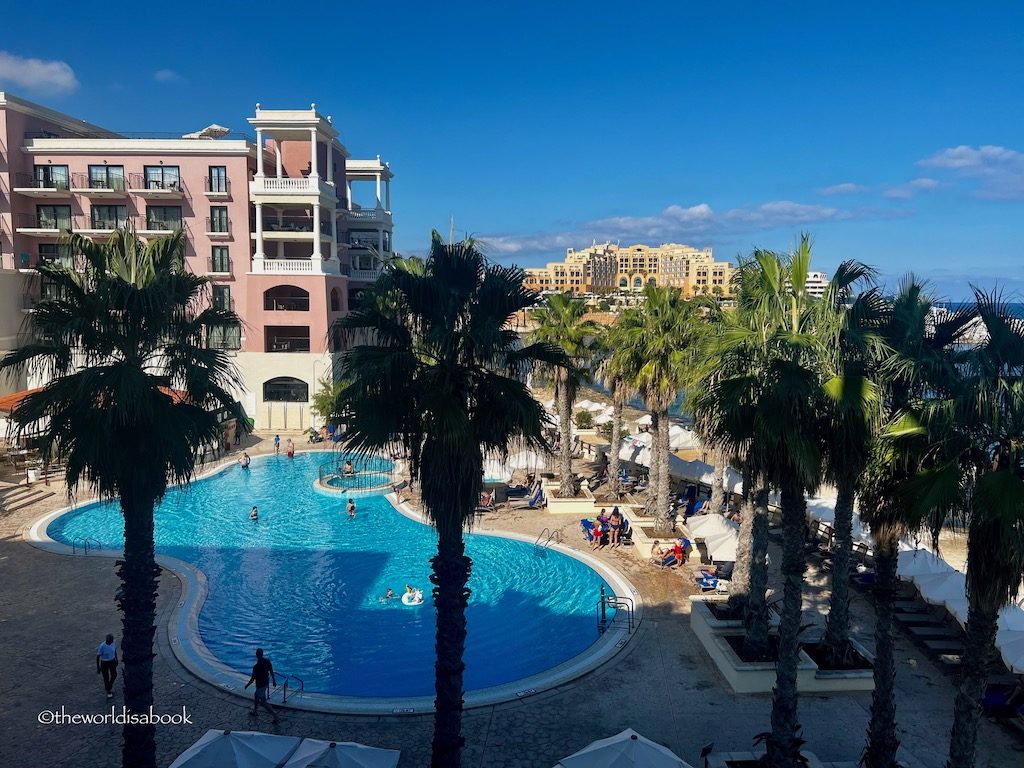
Fun Facts About Malta
*Malta is about 90% Roman Catholic. This is traced back to the arrival of St. Paul the Apostle and the religious order of the Knights of St. John. There are over 300 churches in the country.
*Malta has two official languages. English and Maltese which is a combination of Arabic, Italian and English influences.
*There are over 397,000 vehicles registered in Malta (2019 statistics). This is a lot considering its population is only over 490,000 people. We saw saw many cars and their traffic was pretty bad in some areas.
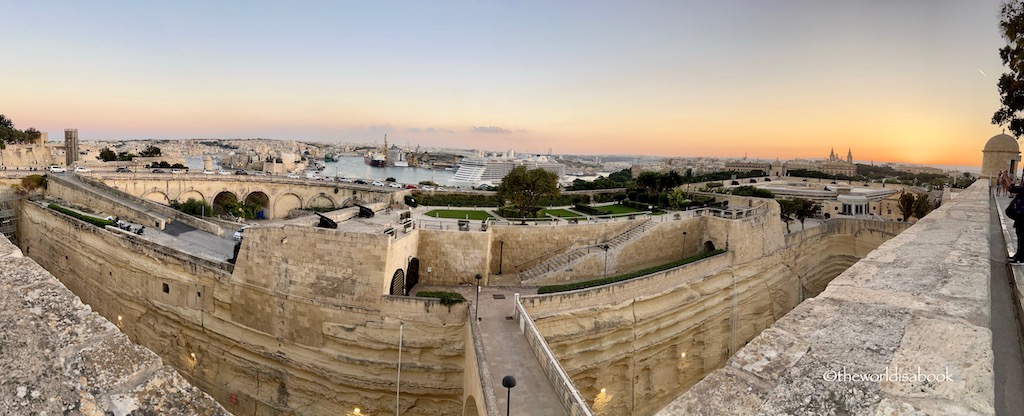
*Glass blowing and Maltese lace are among the top local arts and crafts that were practiced for centuries.
*During the last 2,000+ years, Malta has known 11 foreign rulers that left behind their various traces of architecture and culture that can still be found around the islands.
Pin it for later!
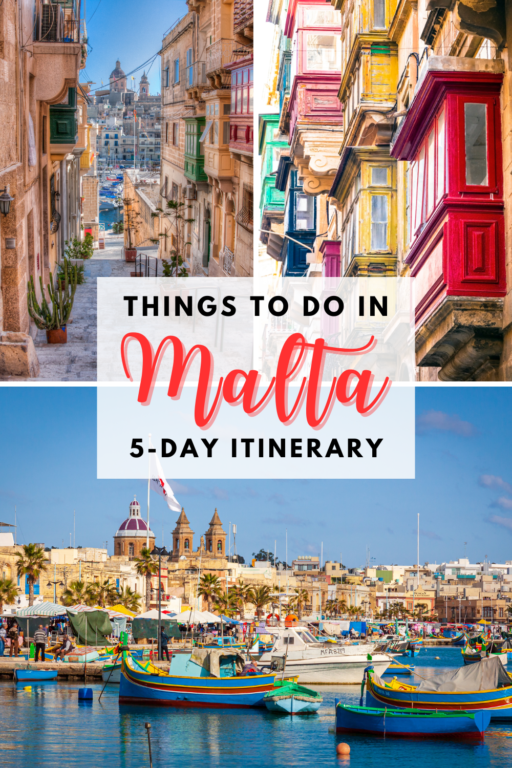
These were great pictures and informative. Were 5 days enough for this trip or would 7-10 days be better?